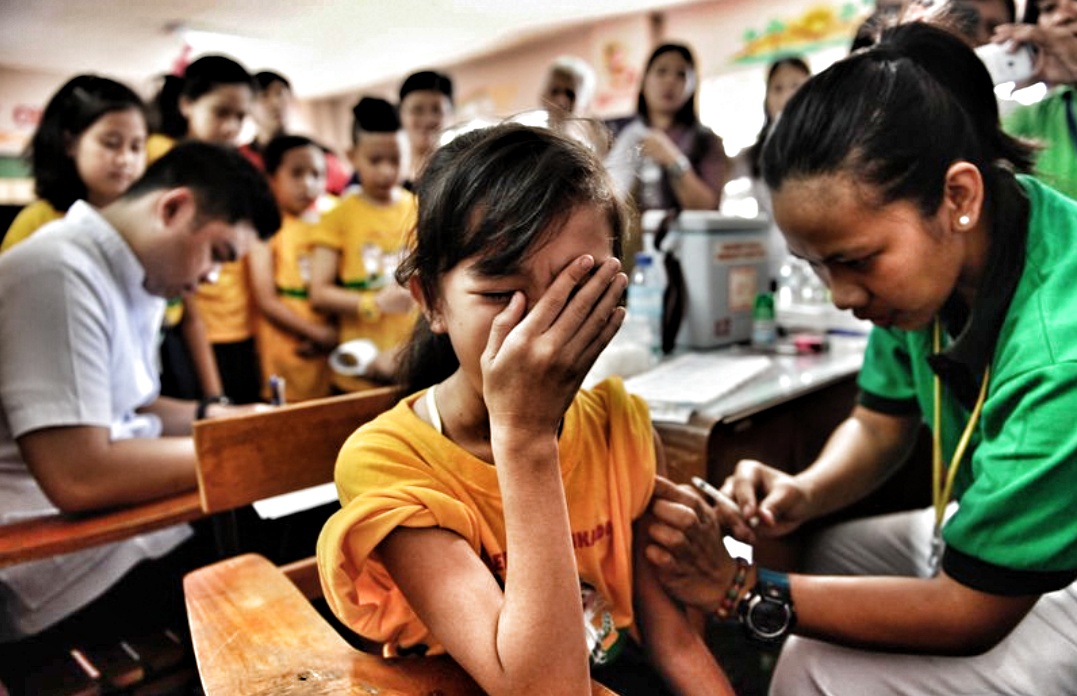
People should get a grip over this recent measles “outbreak”. Partisan camps and social media “influencers” have been polarised between just two camps — (1) the Department of Health (DOH) headed by Sec. Francisco Duque who have been asserting that “low vaccine coverage because of the Dengvaxia scare” is behind this outbreak and (2) the Public Attorney’s Office (PAO) headed by Persida Acosta who had had been drumming up the negative effects of experimental use of Dengvaxia on Filipino children under the the administration of former President Benigno Simeon ‘BS’ Aquino III.
Such is this intellectually-bankrupt noise surrounding this recent outrage fad that it leads one to believe that only two factors are at play in this “outbreak” — (a) insufficient vaccination coverage and (b) fear mongering over vaccinations. As with most emotionally-charged “analyses” by shrill “activists” and “influencers”, the bigger picture is missed because of all the shrieking deliberately skewed towards personal and partisan agendas. Nobody is disputing alleged causes (a) and (b). But before we can conclude that these are the primary causes of the situation and whether Duque and Acosta should be crucified for their “sins” against Filipino humanity, we need to first consider other factors.
Firstly, having one’s kids vaccinated is a personal choice just like it was Christopher Lao’s personal choice to drive his car into a flooded street back in 2011. People then — and now — are screeching “I was not informed!” Well, the information was there. It just wasn’t used. Many of the same Fake News Crybabies who carry on about the “death” of “press freedom”, personal freedoms, and other “freedoms” to do, think, eat, dress, fuck, and act as their hearts desire should, perhaps, really think about what they are wishing upon today’s societies.
Second, the information that supposedly was behind any “scare mongering” surrounding vaccinations was amplified by the chatter of “Netizens” — some well-meaning, others laden with noxious agendas, and, still others, driven by social-climbing goals, plain ignorance, boredom, or some perverse form of delusional sense of self-importance. Indeed, many of the “information” that fuels this circus emanate from social media and, in particular, the force-truncated 256-character “tweets” that encourage more emotionalism and less thinking amongst snowflake millennials and mommy (some yummy, some not) bloggers.
This recent problem like many others that are outcomes of the wrong arguments winning have long been symptoms of a society that rewards popular ideas and thumbs down sober thinking. Recall the obsolete words reminiscent of 1980s-era “activism” — “the people have spoken”, the “people’s will”, “majority rules”. These are now grossly obsolete as they are petridishes upon which propagated the very “fake news” and “misinformation” outbreaks people like Rappler CEO Maria Ressa and her sorority sisters screech about.
To put this “outrage” in perspective look no further back than the Philippines’ appalling civil maritime history. Perhaps 200,000 lives (based on a quick-and-dirty guess) snuffed out in preventable passenger shipping “mishaps” over several decades is not the fashionable “activist” focus nowadays, but that number of souls constitutes “just” 0.2 percent of Filipinos. But more than 10,000 dead in a single “accident” (of several over that period) that could have been prevented is not something normal people would forget. Thing is we not only did forget, it is evident nobody had been thrown into prison for these tragedies. So one ought to be excused if the noise being kicked up over less than a hundred dead in this latest outrage fad would be regarded with a grain of salt.
Third and last (as far as this treatise is concerned), is the question of why the vast majority of all these measles cases were brought to a single hospital. According to the ever-reliable Inquirer Editor, 1,550 patients afflicted with the measles were admitted to a single Manila hospital — San Lazaro. To be fair this is, supposedly, a “referral hospital for communicable diseases”, but considering that the biggest risks to young measles patients involve respiratory problems that could be mitigated by the emergency rooms of most modern general hospitals, one is led to wonder why only one hospital would serve the needs of a vast megalopolis like Metro Manila at a time like this. This points to a broader — and more systemic — problem with the Philippines’ health care system and emergency response services that transcends any one outrage fad kicked off at any one election year.
The common denominator here is not Acosta, Duque, or, for that matter, any high-prorfile government official, celebrity, or social climber who weighs in on or are roped into outrage fads like these. These are, more fundamentally, a reflection on the sort of society the Philippines is at its core — a nation habitually unprepared for routine “natural disasters”, cannot get to an accident scene within those vital seven to eight minutes it takes to save an oxygen-deprived brain, and cannot educate a society out of the paper bag that is its peoples’ deeply-ingrained superstitious and religious beliefs. As usual the “activist” and social-climbing social media “influencers” frame the problem wrong and issue the inevitable wrong argument that their inbred amigas proceed to make popular with their “likes” and “retweets”.

No comments:
Post a Comment